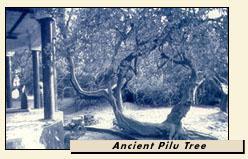 |

Once in while you come across a hidden place of such stunning
beauty that you wonder how it has remained `undiscovered'
for so long...
Such a place is Mansarovar, a rare wetland grove and bird
sanctuary, roughly five acres in size, a few miles across
the Yamuna River from the town of Vrindavan. Local tradition
has it that the lake, or `sarovar', was formed from the
tears of Sri Radha, while in an intensely emotional state
of wounded love, `man'. She came here alone when she feared
she had lost Krishna. In her memory a solitary image of
her is worshipped in a small shrine beside the lake. An
atmosphere of desolation among the surrounding aged bowers
heightens the remote beauty of this place.
Unlike most sacred groves, no
village has grown here. Only the gnarled trees and swaying
palms, which shelter a group of `viraktis'-those indifferent
to the world-who spend their days in prayer and meditation
and tending the shrine. The only other people are pilgrims,
who visit throughout the spring and autumn seasons.
But the real visitors to Manasarovar
are the birds. Crowds of waterfowl and heron frequent the
place. A special visitor is the Sarus Crane, an endangered
species which breeds only in Northern India, but whose total
population is now down to less than 15,000. The Sarus is
the world's tallest flying bird-a male can stand as tall
as six feet-and regarded with reverence in Vraj.
In recent years the lake became
choked with water hyacinth, so much so that the surface
of the water was completely hidden from view. This drove
away the birdlife, who could no longer fish here, and starved
the water of oxygen. However, last autumn a Friends of Vrindavan
team worked hard for six weeks to clear this invasive weed
and restore the lake to its pristine beauty. It was exhausting
and unpleasant work, producing huge heaps of rotting stems
piled about the lake. But now its original beauty is restored
and the birds and wildlife are returning to their previous
haunts.
Work has begun on re-planting
indigenous species of trees, and protecting them with thorny
hedges. We are currently investigating ways of securing the
long-term protection of the lake and surrounding habitat so
as to establish a permanent sacred wildlife sanctuary.Future
plans include the digging out of the lake, which needs to
be done periodically to restore the health of the wetland.
The material removed will be used to create a surrounding
earthbank to further protect the sanctuary and provide a pilgrimage
path, or parikrama, around it.
|